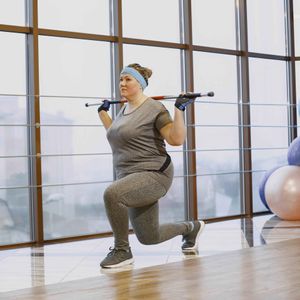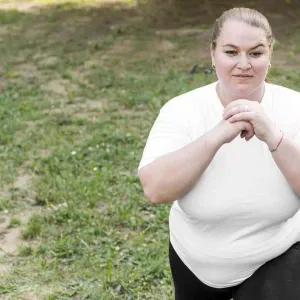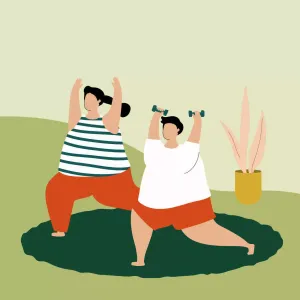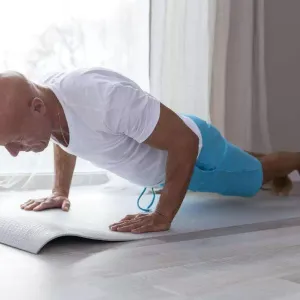

Our Review Process
Our articles undergo extensive medical review by board-certified practitioners to confirm that all factual inferences with respect to medical conditions, symptoms, treatments, and protocols are legitimate, canonical, and adhere to current guidelines and the latest discoveries. Read more.
Our Editorial Team
Shifa Fatima, MSc.
Author
Dr. Apoorva T, MHM.
MEDICAL ADVISOR
Leg Strengthening Exercises for Seniors
Our muscle mass and strength start reducing as we age, especially after 40 years. The more your strength and muscle mass diminish, the less you will be able to perform certain physical activities. Performing some easy yet impactful aerobic exercises and strength training can help you better improve your health. While exercising is essential for people of all ages, it becomes crucial for seniors because it helps them maintain their independence for an extended period. Older adults should focus on strength training of the lower body because your legs support your entire body and help maintain a stable balance.
If you start performing some easy senior leg strengthening exercises consistently, you can notice visible improvements and growing strength in your body. To help seniors get started at the earliest, we have curated the best leg-strengthening exercises for the elderly that can be performed at home. If you are ready to do leg exercises that are safe, effective, and easily doable by seniors, ensure you read until the end.
Table of Contents
What are the Reasons for Weak Leg Muscles in the Elderly?
Plenty of reasons contribute to weaker leg muscles in the elderly. Some of the common causes have been shared below.
1. Peripheral Artery Disease
Peripheral artery disease leads to poor circulation in legs which can restrict blood flow. If you develop this disease, you can experience leg numbness, color changes, cramps, numbness, tingling, etc. Your legs and feet can also start feeling colder than before. If you don’t get it treated, your leg muscles can weaken quickly. People with this disease have higher chances of getting weaker leg muscles faster.
2. Nutritional Deficiency
You may develop weaker leg muscles if you are low on calcium, Vitamin D, magnesium, iron, and other essential micronutrients. Getting the right nutrients is crucial to building muscle tissue and bones. While exercising is an excellent way to strengthen your leg muscles, you must also rely on filling the nutritional gap.
3. Alzheimer’s and Parkinson’s
Both these problems affect walking and gait. It can also influence your body balance. If you have any of these problems, your legs can develop weak muscles over a period, increasing your chances of a fall. It can become common when you get old. Seniors living a sedentary lifestyle can worsen this condition as reduced physical activity can lead to increased muscle loss.
4. Diabetes
Commonly diagnosed in seniors, Diabetes causes more harm than just increasing your blood sugar. It can also reduce blood circulation in your legs, causing extreme leg pain, swelling, cramping, etc. In some cases, it can also develop naturopathy, making you lose any feelings in your leg. Over time, it can cause your leg muscles to weaken.
5. Deep Vein Thrombosis
It is a common problem in aging seniors that signals a blood clot deep within the leg. As a result, the blood pools near the clot, preventing it from returning to the heart. Serious health problems can be created if the blood clot breaks off, traveling to the lungs or heart. People with deep vein thrombosis can develop cramping pain and swelling in the leg.
These are some common problems that lead to weakened leg muscles in seniors. In addition, cardiovascular diseases and a reduction in hormones can also make your leg muscles weak. If you have any of the diseases discussed above, you should start doing senior leg exercises in addition to taking the required medicines to improve the strength of your leg muscles.
What are the Reasons for Sudden Leg Weakness in the Elderly?
Weakness from nutritional deficiency and inactivity takes months before it gradually starts showing effects on the legs. But besides gradual weakness, the elderly can also experience sudden leg weakness caused by numerous factors. A common reason is a slipped disk that generally includes a burning or tingling sensation. The pain developed from this condition worsens when you try to sit or stand and leads to muscle weakness. Another common reason behind sudden leg weakness in seniors is a pinched nerve.
Affecting one side of the body, the common symptoms include pain radiating from the hips, lower back, and legs. Some other reasons behind sudden leg weakness include peripheral neuropathy, Guillain-Barre syndrome, stroke, multiple sclerosis, spinal tumors, Parkinson’s, and other conditions.
10 Effective Leg Strengthening Exercises for Seniors
Building a daily exercising habit can give you incredible results if you have decided to enhance your leg muscles strength. To help you get started, we have listed below the best ten exercises for seniors that can be done at home. All these exercises for weak legs in elderly are effective yet safe and can be started from today. So let’s quickly explore the exercises shared below.
1. Squats
Daily squats can reduce the risk of injury, boost athletic ability, and strengthen your core and lower body muscles. This moderate-intensity leg exercise works on your quads, glutes, back, core, calves, and hips. You can do squats following the below-mentioned steps.
- Stand tall with your feet shoulder-width apart.
- Get a static chair for some support if you’re doing squats for the first time. Now hold onto the chair using both hands.
- Try to gently sit back, hinging at the hips, as you were trying to sit on a chair.
- Don’t go deeper than 90 degrees while trying to sit back and as you stand. Now gently stand up and repeat the same steps at least six to ten times.
While performing squats, remember to distribute equal body weight on both legs while following these steps. Your knees shouldn’t cross the line of your toes or move inwards throughout the exercise.
2. Hip Marching
If you want to start with mild exercises, hip marching is perfect. This simple exercise can help elders build flexibility and strengthen the hips and thighs. It targets your thighs and hip flexors. To perform hip marching, follow the below-mentioned steps.
- Sit straight on a static chair with both feet flat on the ground.
- Inhale as you gently lift your right knee into the air as high as possible.
- Exhale while slowly bringing back the right knee lower on the ground.
- Once you get back to the starting position, follow the same steps with your left knee.
You can follow these steps at least 10 times for each leg. If you want to slightly increase the intensity of this exercise, attach little ankle weights for extra challenge. But it is entirely optional.
3. Side Hip Raise
Elders can perform side hip raise to strengthen their hips for improved walking and side-stepping. It targets your outer thigh muscles and hip abductors, like the minimus and gluteus medius. To perform this exercise, follow the below-mentioned steps.
- Stand up straight behind a firmly placed chair. Keep your ribs lifted, feet flat on the ground, and at hip-width distance.
- Hold onto the back of the chair and inhale as you gently lift your right leg to the side. The foot should be at a right angle, and your toes should be pointing forward. Lift the leg as high as easily possible without bending your hips.
- Exhale while slowly bringing back the right leg to its starting position.
Repeat the same steps 10 times for both legs. If you want to add an additional challenge, try doing this exercise without taking the chair’s support.
4. Knee Extension
It is the easiest leg exercise seniors can perform from home. It primarily targets the quadriceps muscle, making it easier for people to walk, run, jump, squat, etc. With regular knee extensions, you can significantly improve your range of motion. If you want better functioning knees, follow the below-mentioned steps to perform knee extension.
- Sit straight on a firmly placed static chair and keep both the feet flat on the ground.
- Inhale as you gently lift and straighten your right knee in front of you.
- Now tilt your toes towards you, and hold the position for a few seconds.
- Exhale while gently returning the right knee to the ground, and repeat the same steps with the left knee.
You can follow this 10 times for both legs.
5. Lunges
Lunges help strengthen your quadriceps and hips, making it easier to balance your body, stand, and walk. With simple exercises like lunges, you no longer have to limit yourself to leg exercises for elderly in bed. You can follow the below-mentioned steps to perform lunges.
- Stand straight on a clean mat or ground with your hands placed on the hips. Your feet should be shoulder-width apart.
- Exhale as you gently step forward with your right foot, keeping your torso standing up straight and your left foot planted.
- Inhale when you return the right foot back to the starting position, and start repeating the same with the left foot.
You can do this 10 times for both legs.
6. Sit to Stand
One of the easiest yet effective senior leg strengthening exercises, sit to stand strengthens your lower body. It targets the muscles in your core and thighs. If you face difficulty getting up from bed, toilet, chair, etc., this exercise can help you over time. If you are ready to strengthen your hips and legs, follow the below-mentioned steps to perform the exercise.
- Stand tall in front of a chair, and ensure the back of your knees touch the seat.
- Once ready, inhale as you lean forward and bend from your hips towards the chair. Stop before you finally sit down.
- Now pause and exhale as you raise yourself back to the starting position.
Follow these steps 10 times for the best results.
7. Straight Leg Raise
It is one of the simplest senior leg exercises you can perform at home. Ideal to strengthen the quadriceps, hip flexors, and abdominal muscles, this exercise helps improve your overall body balance and flexibility. Follow the below-mentioned steps to perform a straight leg raise correctly.
- Lay down on a clean mat, ensuring your lower back touches the ground.
- Bend your left knee while keeping your foot on the ground/surface and your right leg straight. The palms of both hands should be flat against the floor.
- Now inhale as you gently raise your right leg to the height of your left bended knee. The right leg should remain in a straightened position. Try to hold this same position for at least 5 seconds.
- Exhale while bringing the right leg gently to the ground.
- Once the starting position is achieved, follow the same steps with the left leg.
It should be followed 10 times for each leg.
8. Heel Stand
A heel stand can help you improve your balance and stand. Aimed at promoting ankle stretching, this exercise gets the blood flowing in your legs. It targets your soleus, medial gastrocnemius, and lateral gastrocnemius. You can follow the below-mentioned steps to perform a heel stand.
- Stand up behind a chair and hold onto its back for support. Your back should be straight and your ribs lifted.
- Inhale when you roll back onto your heels, gently lifting your toes from the ground.
- Exhale when you bring them back lower to the ground.
You can repeat this at least 10 times for proper heel stretching.
9. Step-Ups
If you want to climb stairs and step over things without any challenge, this exercise is perfect. Similar to climbing stairs, this exercise helps build your quadriceps and glutes. You can follow the below-mentioned steps to practice step-ups.
- Stand up straight at the bottom of your staircase and hold onto the railing for support.
- Slowly put your right foot forward and step up, firmly placing the foot on the step.
- Now follow the same with your left foot. Slowly step back down using your left foot.
Repeat the same at least 10 times for both legs.
10. Standing Knee Flexion
This leg exercise improves your walking and standing. It primarily targets your hamstring muscles, increasing your ability to flex and bend your knee. You can perform standing knee flexion following the below-mentioned steps.
- Stretch your hamstring for at least 5 seconds before starting the exercise.
- Stand up behind the chair, and hold onto the back of the chair for balance.
- Inhale as you gently raise your right foot behind you and bend the knee backward. The knees should be bending at a right angle. Don’t bend at the hips.
- Exhale when you gently return your right foot to standing flat on the ground.
- Now do the same with your opposite foot.
Repeat this 10 times for each leg.

Don’t Let Old Age Affect Your Mobility
Weak legs can affect your overall well-being and restrict your ability to move. Although muscle loss will occur as you age, you can minimize its effects with regular leg exercises. Seniors already suffering from weak leg muscles should follow a simple workout plan aimed at strengthening their leg muscles. You can start practicing the exercises this article covers to get visible results. However, you must remain consistent to see any result or improvement.
FAQs
Can Elderly Regain Leg Strength?
Yes, the elderly can regain leg strength. You will notice improvements if you do strength training at least three days a week and focus on engaging your major muscle groups during every workout session. You can also add some weight training to your routine for even better results. If you remain consistent with the routine, you can notice improved flexibility and strength in your legs.
What Helps Weak Legs in the Elderly?
The right combination of daily exercises and a healthy diet can help strengthen weak legs in the elderly. Elevating feet and legs at least 6 to 12 inches above the heart can relieve pressure from both legs. Poor blood circulation can easily put pressure onto your legs, affecting the leg and lower body extremities, so elevating your legs can also help.
What Vitamins Help Weak Legs?
Your leg muscles require appropriate amounts of certain vitamins and minerals to contract and perform other functions properly. Some important vitamins necessary to help weak legs include Vitamin K, Vitamin C, Vitamin D, Vitamin B6, etc. Your legs also require potassium, calcium, sodium chloride, iron, magnesium, and phosphorus for proper functioning.
What is the Most Common Cause of Leg Weakness?
There are numerous causes of leg weakness among different people, but medication side effects, systemic disease, and inflammatory conditions are the most common causes. If you have any autoimmune diseases, infections, damaged muscles, alcohol-related disorders, or damaged nervous system, you can develop leg weakness over a period.
Disclaimer
This website's content is provided only for educational reasons and is not meant to be a replacement for professional medical advice. Due to individual differences, the reader should contact their physician to decide whether the material is applicable to their case.








